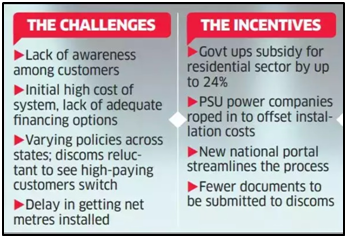Pradhan Mantri Suryodaya Yojana
23-01-2024
09:21 AM
1 min read

What’s in today’s article?
- Why in news?
- Previous schemes to promote rooftop solar system
- Pradhan Mantri Suryodaya Yojana
- India’s current solar capacity
- Need for an expansion of solar energy in India

Why in news?
- PM Modi announced the ‘Pradhan Mantri Suryodaya Yojana’, a government scheme under which one crore households will get rooftop solar power systems.
Previous schemes to promote rooftop solar system
- About
- In 2014, the government launched the Rooftop Solar Programme.
- This had aimed to achieve a cumulative installed capacity of 40,000 megawatts (MW) or 40 gigawatts (GW) by 2022.
- Watt is a unit of power and is calculated as the amount of energy used over time, specifically one Joule per second.
- The scheme aimed to expand India’s rooftop solar installed capacity in the residential sector by providing Central Financial Assistance and incentives to DISCOMs (distribution companies).
- Achievement
- However, this target could not be achieved. But by the end of 2023, rooftop solar energy generation was just 11 GW.
- And energy generated from residences was only about a fifth of that.
- As a result, the government extended the deadline from 2022 to 2026.
- However, this target could not be achieved. But by the end of 2023, rooftop solar energy generation was just 11 GW.
- Features
- A consumer can avail of benefits of the scheme through DISCOM tendered projects or through the National Portal (solarrooftop.gov.in)
- The DISCOMs role is limited to issuing of technical feasibility approval, installation of net-meter and inspect the system.
- Net metering is a billing mechanism that credits solar energy system owners for the electricity they add to the grid.
- Surplus solar power units generated from the rooftop solar plant can be exported to the grid.
- The consumer can receive monetary benefits for the surplus exported power as per the prevailing regulations.
- Challenges and incentives
Pradhan Mantri Suryodaya Yojana
- This scheme is a new attempt to help reach the target of 40 GW rooftop solar capacity.
- It will involve installing solar power systems at rooftops for residential consumers.
- The scheme would help not only reduce electricity bills of the poor and middle class, but also push India’s goal of becoming self-reliant in the energy sector.
India’s current solar capacity
- Installed capacity
- According to the Ministry of New and Renewable Energy, solar power installed capacity in India has reached around 73.31 GW as of December 2023.
- Meanwhile, rooftop solar installed capacity is around 11.08 GW as of December 2023.
- Overall, solar power has a major share in the country’s current renewable energy capacity, which stands at around 180 GW.
- High performing states
- In terms of total solar capacity, Rajasthan is at the top with 18.7 GW. Gujarat is at the second position with 10.5 GW.
- When it comes to rooftop solar capacity, Gujarat tops the list with 2.8 GW, followed by Maharashtra by 1.7 GW.
Need for an expansion of solar energy in India
- According to the latest World Energy Outlook by the International Energy Agency (IEA), India is expected to witness the largest energy demand growth of any country or region in the world over the next 30 years.
- IEA is an intergovernmental organization that provides data, policy recommendations, and analysis on the global energy sector.
- IEA's goal is to help countries provide sustainable and secure energy for everyone.
- To meet this demand, the country would need a reliable source of energy and it can’t be just coal plants.
- Although India has doubled down on its coal production in recent years, it also aims to reach 500 GW of renewable energy capacity by 2030.
Q1) What is Net metering?
Net metering is a billing system that allows consumers to use their own electricity at any time, instead of when it's generated. It also credits solar energy owners for the power they add to the grid.
Q2) What are DISCOMs?
DISCOMs are distribution companies that transport electricity from high-voltage transmission lines to low-voltage distribution lines. They also manage the local power grid, which includes substations, transformers, and power lines.
Source: PM Modi launches new rooftop solar power scheme: What it is, why it is needed | Economic Times | The Hindu | Times of India


